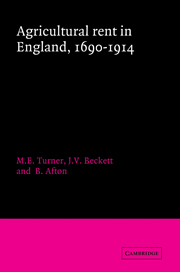Book contents
- Frontmatter
- Contents
- List of figures
- List of tables
- Preface
- Note on the text
- List of abbreviations
- Two examples of contemporary rent books
- Introduction
- 1 Agricultural rent in England
- 2 Contemporary views of rent in eighteenth and nineteenth-century England
- 3 The current state of knowledge
- 4 The determining parameters of a rent index
- 5 Constructing the rent index I: estate records
- 6 Constructing the rent index II: government inquiries
- 7 Constructing the rent index III: other studies
- 8 An English agricultural rent index, 1690–1914
- 9 Rent arrears and regional variations
- 10 The rent index and agricultural history I: the long term
- 11 The rent index and agricultural history II: the short term
- Conclusion
- Appendix 1 Sources of the rent index
- Appendix 2 Statistical summary
- Bibliography
- Index
7 - Constructing the rent index III: other studies
Published online by Cambridge University Press: 02 December 2009
- Frontmatter
- Contents
- List of figures
- List of tables
- Preface
- Note on the text
- List of abbreviations
- Two examples of contemporary rent books
- Introduction
- 1 Agricultural rent in England
- 2 Contemporary views of rent in eighteenth and nineteenth-century England
- 3 The current state of knowledge
- 4 The determining parameters of a rent index
- 5 Constructing the rent index I: estate records
- 6 Constructing the rent index II: government inquiries
- 7 Constructing the rent index III: other studies
- 8 An English agricultural rent index, 1690–1914
- 9 Rent arrears and regional variations
- 10 The rent index and agricultural history I: the long term
- 11 The rent index and agricultural history II: the short term
- Conclusion
- Appendix 1 Sources of the rent index
- Appendix 2 Statistical summary
- Bibliography
- Index
Summary
Our own analysis of archival material, coupled with the evidence collected by and in connection with the late-nineteenth-century Royal Commission, has provided the greater part of the data from which we have compiled a rent index. However, we commented in an earlier chapter that many large estates, in particular, had been the subjects of biographies. We turn in this chapter to considering whether any of the materials in these studies can be added in a satisfactory way to the database. While any conclusions will be regionally specific (except perhaps in the case of large and scattered estates), the least we can do perhaps is to attempt to build up an impressionistic picture. Since contemporaries were often uncertain about the calculation of rent, there is little likelihood that historians collecting rent material will have acquired data which can easily be compared. None the less it may be that material collected for individual estates across long time spans offers us a way of shadowing a rent index to ensure that we have the correct framework.
For the mass of landowners there is barely the odd estate history to rely on, let alone a collective story to be told. Yet from these individual biographies there are some families and some estates which have been picked over more than once. Potentially we could piece together the longest continuous single series for a family and its estate by splicing together the researches of the several biographers of the Leveson-Gower/Sutherland estates in Staffordshire and Shropshire. Four scholars have worked on the family archive in the production of doctoral theses.
- Type
- Chapter
- Information
- Agricultural Rent in England, 1690–1914 , pp. 138 - 147Publisher: Cambridge University PressPrint publication year: 1997



